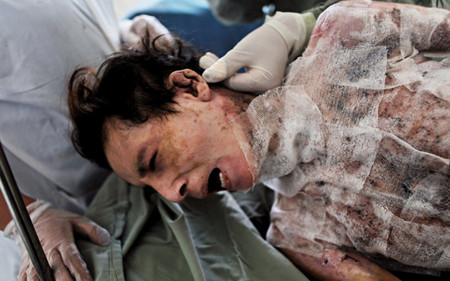By Cesar Chelala
Self-immolation committed by a large number of Afghan women is one of the most tragic responses to gender violence in that country. Aside from the horror of dying, surviving this act makes victims unfit for a normal life. They are often permanently maimed, disfigured and shunned by their communities. Unless current laws regarding the protection of women are implemented in full, the consequences of gender violence will continue to exact a punishing effect on women’s lives in Afghanistan. Self-immolation is perceived as the only response available to some women who want to escape domestic abuse, forced marriage or other misogynistic social customs.

Hanifa, 15, screams as she has her bandages changed for the first time since undergoing skin graft surgery in the burn center of the Herat Regional Hospital in Herat, Afghanistan. Hanifa claimed she turned to commit suicide after being beaten by her mother-in-law. (Photo: Lynsey Addario for the New York Times http://www.nytimes.com/interactive/2010/11/08/world/asia/20101108_burn.html?ref=asia)
Although many Afghans — including some religious leaders — reinforce these social customs based on their interpretation of Islam, these practices are inconsistent with Shariah law as well as with Afghan and international law in that they violate women’s basic human rights.
Reliable national statistics on this phenomenon are not available, since many families cover up these acts because of shame. Lack of good medical care and adequate government services means that such events are never officially recorded. The Afghanistan Independent Human Rights Commission (AIHRC) reported 106 cases of self-immolation in 2006 and 184 cases in 2007. It is feared that the phenomenon has continued to grow.
What makes the situation even more troublesome is that the police and judiciary do not conduct any formal investigations to determine the causes of suicide, according to AIHRC. “There is a culture of impunity for those who push women to self-immolation and suicide,” remarks Homa Sultani, a researcher on women’s rights at AIHRC. Women’s self-immolation in Afghanistan is a reflection of their disadvantaged situation in social and health areas. Some statistics are telling: 87 percent of Afghan women are illiterate; more than one in three women experience physical, psychological or sexual violence; and 70 to 80 percent of women face forced marriages.
Some people feel that marriage in Afghanistan is, in some cases, like a form of sale in which women are traded to solve family disputes or strengthen family bonds. In this context, forced marriages with underage girls often occur in defiance of national law, which stipulates that women must be 16 to marry. Some girls are married off to men who are five times their age.
The majority of Afghan women are victims of mental and sexual violence, which compels them to commit suicide or engage in drug abuse. Most of the recorded cases occur in Afghanistan’s main cities; those that occur in rural areas are not recorded. There is a way to lower the incidence of this tragedy. In August 2009, the Afghan government enacted the Law on Elimination of Violence against Women (EVAW), which criminalizes many harmful traditional practices. Although passage of the law was a significant achievement, the Human Rights, United Nations Assistance Mission in Afghanistan (UNAMA HR) found that law enforcement authorities are often unwilling or unable to apply laws that protect women’s rights. Such inaction is one of the main factors that allow these practices to continue.
What is urgently needed is for the government of Afghanistan to create the conditions for full implementation of the EVAW law. As the UNAMA HR has indicated, “Convictions under the EVAW law can result in deterring perpetrators of violence against women.” At the same time, Afghanistan’s President Hamid Karzai should indicate that respect for women’s rights is at the core of the government’s human rights policy.
—The writer is an international public health consultant.



